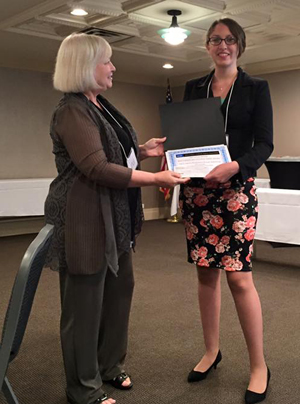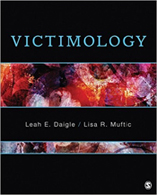Here is a list of publications recently produced by faculty, students and alumni of Sam Houston State University, College of Criminal Justice.
Alexander, M. B., Hodges, T. K., Bytheway, J., & Aitkenhead-Peterson, J.A. (2015). Application of soil in forensic science: Residual odor and HRD dogs. Forensic Science International. Advance online publication.
Blasko, B. L., Friedmann, P. D., Rhodes, A. G., & Taxman, F. S. (2015). The parolee-parole officer relationship as a mediator of criminal justice outcomes. Criminal Justice and Behavior, 42(7), 722-740.
Boutwell, B. B., Nedelec, J., *Lewis, R. H. & Beaver, K. M. (2015). A behavioral genetic test of the evolutionary taxonomy. Evolutionary Psychological Science. Advance online publication.
Cuvelier, S. J., *Jia, D., & Cheng, J. (2015). Chinese police cadets’ attitudes toward police roles revisited. Policing: An International Journal of Police Strategies & Management, 38(2), 250-264.
Diamond, B., **Morris, R. G., & Piquero, A. R. (2015). Stability in the underlying constructs of self-control. Crime & Delinquency. Advance online publication.
**Grubb, J. A., & Nobles, M. R. (2015). A spatiotemporal analysis of arson. Journal of Research in Crime and Delinquency. Advance online publication.
Haigle, L.E., &Muftić, L. (2015). Victimology. Thousand Oaks, CA: Sage Publications.
Hayes, B. (2015). Impact of victim, offender, and relationship characteristics on frequency and timing of intimate partner violence using life history calendar data. Journal of Research in Crime and Delinquency. Advance online publication.
Hayes, B. (2015) Indirect abuse involving children during the separation process. Journal of Interpersonal Violence. Advance online publication.
Kerrigan, S., **Savage, M., **Cavazos, C., & **Bella, P. (2015). Thermal degradation of synthetic cathinones: Implications for forensic toxicology. Journal of Analytical Toxicology. Advance online publication.
King, W., & Wells, W. (2015). Impediments to the effective use of ballistics imaging information in criminal investigations: Lessons from the use of IBIS in a developing nation. Forensic Science Policy & Management: An International Journal, 6(1-2), 47-57.
**Lee, J., & Gibbs, J. C. (2015). Race and attitudes toward police: The mediating effect of social distance. Policing: An International Journal of Police Strategies & Management, 38(2), 314-332.
Lu, H., Liang, B., *Li, Y. & He, N. (2014) Professional commitment and job satisfaction: An analysis of the Chinese judicial reforms from the perspective of the criminal defense. The China Review: An Interdisciplinary Journal on Greater China, 14(2), 159-181.
Lytle, D. J., &Randa, R. (2015). The effects of police satisfaction on fear of crime in a semirural setting. International Criminal Justice Review. Advance online publication.
Maguire, E. R., King, W. R., Wells, W.,& Katz, C. M. (2015). Potential unintended consequences of the movement toward forensic laboratory independence. Police Quarterly, 18(3), 272-292.
Muftić, L. R., Bouffard, L. A., & Armstrong, G. S. (2015). Impact of maternal incarceration on the criminal justice involvement of adult offspring: A research note. Journal of Research in Crime and Delinquency. Advance online publication.
**Nolasco, C.A.R.I., del Carmen, R.V., **Steinmetz, Vaughn, M. S., & Spaic, A. (2015). Building legal competency: Foundations for a more effective criminology and criminal justice discipline. Journal of Criminal Justice Education, 26(3), 233-252.
*Smith, M., Muftić, L. R., Deljkic, I., & **Grubb, J. A. (2015). Perceptions of the sex trade in Bosnia and Herzegovina: A comparative analysis of practitioners and future practitioners. International Criminal Justice Review, 25(2), 174-193. DOI: 10.1177/1057567715577832
Tibbetts, S. G., & **Hemmens, C. (2015). Criminological Theory, 2nd ed. Thousand Oaks, CA: Sage Publications.
**Wells, J., Armstrong, T., Boutwell, B., Boisvert, D., Flores, S., **Symonds, M., &Gangitano, D. (2015). Molecular genetic underpinnings of self-control: 5-HTTLPR and self-control in a sample of inmates. Journal of Criminal Justice, 43(5), 386.
White, J., Hughes-Stamm, S., & Gangitano, D. (2015). Development and validation of a Rapid PCR Method for the PowerPlex® 16 HS System for forensic DNA identification. International Journal of Legal Medicine, 129(4), 715-723 (2015).
Key
Bold: Faculty
*: Doctoral Students
**: Alumni
 Retired Lt. Dan Webb of the Texas Department of Public Safety (DPS) was one of the first officers in the state certified in sobriety field testing and as a drug recognition expert (DRE). Last month, he was named the latest DRE Emeritus for the honor and integrity he brought to the nationwide program.
Retired Lt. Dan Webb of the Texas Department of Public Safety (DPS) was one of the first officers in the state certified in sobriety field testing and as a drug recognition expert (DRE). Last month, he was named the latest DRE Emeritus for the honor and integrity he brought to the nationwide program. “The NABCJ informs minorities about legislation that may affect them and educates them about how they can change the system and how we are a major part of the system,” said Xavier Perry, President of the SHSU NABCJ and Vice President of the Student Council for the national organization. “The NABCJ is really serious about minorities getting just representation.”
“The NABCJ informs minorities about legislation that may affect them and educates them about how they can change the system and how we are a major part of the system,” said Xavier Perry, President of the SHSU NABCJ and Vice President of the Student Council for the national organization. “The NABCJ is really serious about minorities getting just representation.” The program was sponsored by the Collin County Fire & Arson Investigators Association (CCFAIA), an agency formed in 2013 to deliver training tied to academic programs, the scientific method, hands-on exercises and the study of pre- and post-fire causes. The program was attended by 62 fire marshals, investigators and attorneys from small and large agencies across the country , including the Texas Rangers, The Texas State Fire Marshal’s Office, the federal Bureau of Alcohol, Tobacco, Firearms and Explosives, and representatives from Arkansas, Nevada, Oklahoma, McAllen, Guadalupe County, Wichita County, Sequin, and Waco, to name a few.
The program was sponsored by the Collin County Fire & Arson Investigators Association (CCFAIA), an agency formed in 2013 to deliver training tied to academic programs, the scientific method, hands-on exercises and the study of pre- and post-fire causes. The program was attended by 62 fire marshals, investigators and attorneys from small and large agencies across the country , including the Texas Rangers, The Texas State Fire Marshal’s Office, the federal Bureau of Alcohol, Tobacco, Firearms and Explosives, and representatives from Arkansas, Nevada, Oklahoma, McAllen, Guadalupe County, Wichita County, Sequin, and Waco, to name a few. The training was prompted by a 2011 report by the Texas Forensic Science Commission (TFSC) on two arson cases, which resulted in death penalty convictions for Ernest Willis and Cameron Todd Willingham in two separate cases in 1986 and 1992. Both cases were based on similar assumptions, findings and conclusions by state and local arson investigators who concluded that each man had set fire to houses and killed occupants. However, Willis’ case was dismissed in 2004; Willingham was executed that same year.
The training was prompted by a 2011 report by the Texas Forensic Science Commission (TFSC) on two arson cases, which resulted in death penalty convictions for Ernest Willis and Cameron Todd Willingham in two separate cases in 1986 and 1992. Both cases were based on similar assumptions, findings and conclusions by state and local arson investigators who concluded that each man had set fire to houses and killed occupants. However, Willis’ case was dismissed in 2004; Willingham was executed that same year.  “In “Indirect Abuse Involving Children During the Separation Process” Dr. Brittany Hayes, Assistant Professor at the College of Criminal Justice, said that victims of intimate partner violence continue to suffer from abuse after separation, but few recognize the indirect abuse of children during the process.
“In “Indirect Abuse Involving Children During the Separation Process” Dr. Brittany Hayes, Assistant Professor at the College of Criminal Justice, said that victims of intimate partner violence continue to suffer from abuse after separation, but few recognize the indirect abuse of children during the process. Alicia Jurek, a first year Ph.D. student at the College of Criminal Justice, was awarded the Outstanding Graduate Student Paper for 2015 by the Midwestern Criminal Justice Association.
Alicia Jurek, a first year Ph.D. student at the College of Criminal Justice, was awarded the Outstanding Graduate Student Paper for 2015 by the Midwestern Criminal Justice Association.
 Dr. Melinda Tasca of the Department of Criminal Justice and Criminology was recently elected as a member of the distinguished American Society of Criminology Division of Corrections and Sentencing Executive Board.
Dr. Melinda Tasca of the Department of Criminal Justice and Criminology was recently elected as a member of the distinguished American Society of Criminology Division of Corrections and Sentencing Executive Board. Dr. Lisa Muftić was recently appointed as Director of Undergraduate Programs in the Department of Criminal Justice and Criminology at Sam Houston State University.
Dr. Lisa Muftić was recently appointed as Director of Undergraduate Programs in the Department of Criminal Justice and Criminology at Sam Houston State University.  During the 2012-2013 academic year, Dr. Muftić was appointed the United States J. William Fulbright Scholar to Bosnia and Herzegovina where she was a visiting faculty member with the Faculty of Criminal Justice Sciences, Criminology and Security Studies at the University of Sarajevo. She has conducted field work in Bosnia and Herzegovina related to intimate partner violence, law enforcement responses to human trafficking in the region, and the impact reformation efforts have had on police attitudes and behaviors. Dr. Muftić recently co-authored her first book, Victimology, with Dr. Leah E. Daigle, and she has published scholarly works in well-respected refereed journals including Justice Quarterly, Crime & Delinquency, and the Journal of Research in Crime and Delinquency.
During the 2012-2013 academic year, Dr. Muftić was appointed the United States J. William Fulbright Scholar to Bosnia and Herzegovina where she was a visiting faculty member with the Faculty of Criminal Justice Sciences, Criminology and Security Studies at the University of Sarajevo. She has conducted field work in Bosnia and Herzegovina related to intimate partner violence, law enforcement responses to human trafficking in the region, and the impact reformation efforts have had on police attitudes and behaviors. Dr. Muftić recently co-authored her first book, Victimology, with Dr. Leah E. Daigle, and she has published scholarly works in well-respected refereed journals including Justice Quarterly, Crime & Delinquency, and the Journal of Research in Crime and Delinquency.
 “It’s nice that we just don’t read stuff that comes out of a book, but we now get to go out in the field and make something out of what we are learning,” said Spencer Copeland, a graduate student.
“It’s nice that we just don’t read stuff that comes out of a book, but we now get to go out in the field and make something out of what we are learning,” said Spencer Copeland, a graduate student.